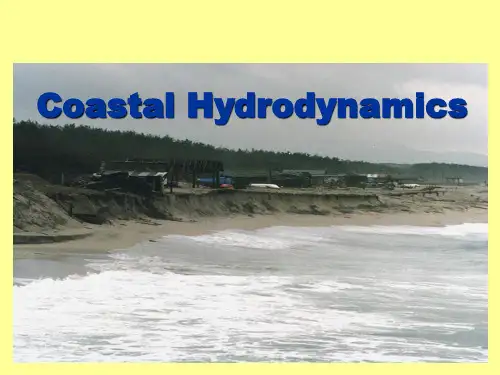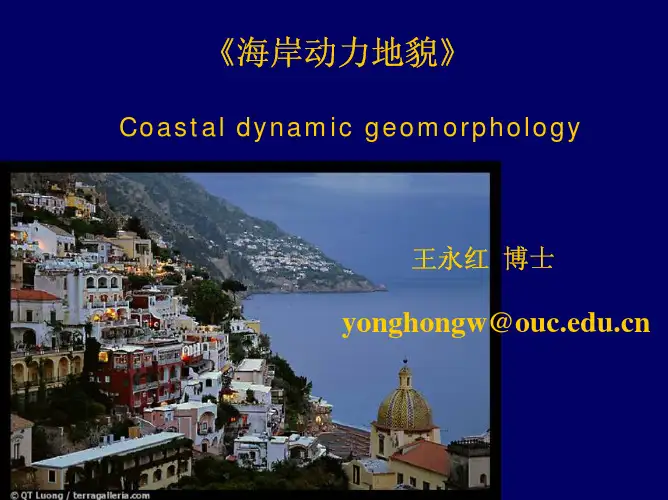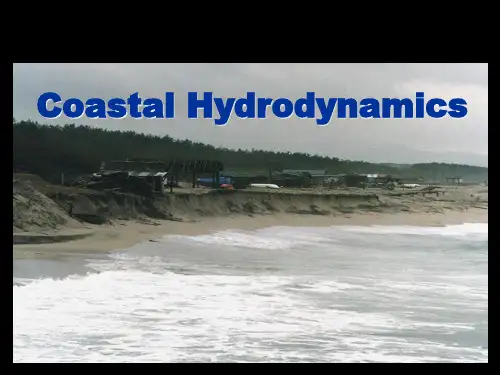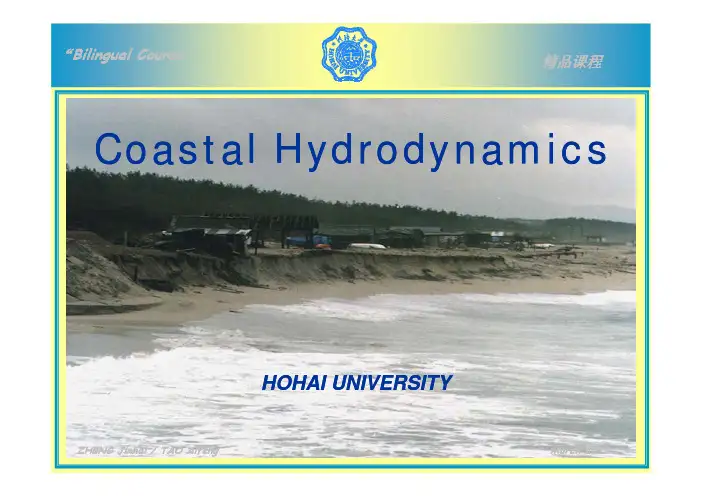海岸动力地貌学(王永红编著)PPT模板
- 格式:pptx
- 大小:1002.45 KB
- 文档页数:38








“Bilingual Course”精品课程Coastal Hydrodynamics C t l H d d iHOHAI UNIVERSITYAifeng March 2013 / TAO AifengZHENGZHENG JinhaiJinhai/ TAO2.3 Small Amplitude Wave TheorySmall Amplitude Wave Theory §2.323S A iLinearization of basic equations1. 1. Linearization of basic equations2. 2. Solution of the linearized equationsSolution of the linearized equationsDynamic & kinetic characteristics3. 3. Dynamic & kinetic characteristicsof small amplitude wavesStanding waves4. 4. Standing waves2/383. Dynamic & kinetic characteristics¾Water particle velocity components¾Water particle trajectoryPressure field¾Pressure fieldEnergy and energy propagation ¾Energy and energy propagation3/38Velocity componentsThe velocity components can be found byy psubstituting the solution of velocity potentiali t th d fi iti f t ti l f tiinto the definition of potential function.4/38Velocity components are harmonic functions of V l it t h i f ti f x and t.y pThe horizontal velocity component has the same phase as the elevation of the free surface.The horizontal and vertical components are 90 The horizontal and vertical components are 90ººout of phase.Velocity components decrease exponentially with depthwith depth.5/38Water particle trajectoryThe displacement of the water particle can bep j yfound by integrating the velocity with respect to time.to time.Squaring and adding yields the water particle path as6/38The water particles travel in an elliptical path. The water particles travel in an elliptical path. The elliptical motion becomes flatter withwater depth.water depthp,In deep water, the orbits become true circles. In shallow water, the major diameters of ellipses are constant.7/38Pressure fieldThe pressure field associated with a progressive wave is determined from the unsteady Bernoulli equation.tiThe pressure equation contains two terms:h h d ithe hydrostatic pressure (静水压强) & the dynamic pressure (动水压强)&the dynamic pressure8/38The dynamic pressure is in phase with the water Th d i i i h ith th tpsurface elevation. It is positive where the free surface is above the SWL, and is negative where the free surface is below the SWL.In deep water dynamicI d d ipressure is very smallp yat the bottom, whilein shallow water itapproaches unity.approaches unity.9/38The maximum value or the minimum one appears when wave crest or trough reaches a given point when wave crest or trough reaches a given point respectively.Hydrostatic & dynamic pressure at various phases10/38is referred to as the “pressure response The term Ki f“zfactor(压力响应系数).”The “pressure response factor” has a maximum of unity at the mean water level and a minimum at the bottom.Below the mean water surface,at the bottom. Below the mean water surface,it is always less than unity.11/38A commonly used method to measure waves in either the laboratory or field by sensing the either the laboratory or field by sensing the pressure fluctuations is stated as follows.If the dynamic pressure is isolated by subtracting out the mean hydrostatic pressure, then the free t th h d t ti th th f surface displacementη ispWave energyThe total energy consists of two kinds:the potential energy (势能), resulting from the displacement of the free surface;the kinetic energy(动能), due to the orbitalmotion of the water particles.13/38The potential energy per unit crest width over The potential energ per nit crest idth o er one wave length isThe kinetic energy per unit crest width of a wave iswave isThe total energy per wave per unit width is The total energy per wave per unit width isFor Airy waves the potential energy is equal Ai i ito the kinetic energy, which is characteristic to the kinetic energy,which is characteristic of conservative (nonof conservative (non--dissipative) systems.It is worthwhile emphasizing that neither the It is worthwhile emphasizing that neither the average potential nor kinetic energy per unit area depends on water depth or wave length, but each is simply proportional to the square b t h i i l ti l t thof the wave height.of the wave height.15/38Energy fluxThe rate at which the energy is transferred in thegydirection of wave propagation is called thefl d i i h hi h energy flux (波能流), and it is the rate at which work is being done by the fluid on one side of a work is being done by the fluid on one side of a vertical section on the fluid on the other side. The relationship for the energy flux isEnergy flux has the units of power, and for thatreason it is denoted by P; it is commonly referred it i d t d b it i l f dto as the wave power(波功率).to as the wave powerIn deep water, the energy is transmitted at onlyhalf the speed of the wave profile (n=1/2), and half the speed of the wave profile()andin the shallow water, the profile and energyin the shallow water,the profile and energytravel at the same speed (n=1).17/38Conservation of the energy flux will be used later to examine the wave height variationsgin shoaling waves and to relate the heightdeep--water wave of breaking waves to the deepconditions..conditionsThe rate of sand transport along beaches is commonly correlated with the “longshorel l t d ith th“l h component of the energy flux”component of the energy flux.18/38p y(群)Group velocity 群速If there are two trains of waves of the same height propagating in the same direction with a slightly different frequencies and wavethe resulting profile, is modulated, is modulated numbers,numbers, the resulting profileb th lti fil i d l t d by an envelop that propagates with speed of by an‘envelop’that propagates with speed of group velocity.Characteristics of a group of wavesIt is clear that no energy can propagate past a node It is clear that no energy can propagate past a nodenergy as the wave height is zero there. Therefore, theas the wave height is zero there. Therefore, the nergy must travel with the speed of the group of waves.20/38Sequence of photographs showing a planeprogressive wave system advancing intoclam waterwater..The water is darkened withdye,and the lower half of the water depthis not shownshown..The wave energy islinescontained within the heavy diagonal lines,and propagate with group velocityvelocity..Theposition of one wave crest is connected ini h t h b th li ht lisuccessive photographs by the light line,which advances with the phase velocityvelocity..Each wave crest moves with the phasevelocity,equal the twice the groupvelocityvelocity..Thus each wave crest vanishes atthe front end and,after the wave maker isturned off,arises from calm water at thebackback..The interval between successivephotographs is0.2525s s and the wave periodis0.3636s s.The wavelength is0.2323m m and thewater depth is0.1111m m.21/38“Marine Hydrodynamics”___J.N. Newman (MIT), 1977The speed at which the energy is transmitted is equal to the group velocity. .equal to the group velocityThe average rate of energy propagation per unit crest width over one wave period is seen to be the average energy per unit surface area progressing with the group velocity.22/38The group velocity is defined asThe group velocity is defined asThis derivative can be evaluated from the This derivative can be evaluated from the dispersion relationshipp p4. Standing waves4 Standing wavesStanding waves立波often occur when incoming g(波)g waves are completely reflected by vertical walls. If a progressive wave were normally incident on a vertical wall, it would be reflected backward without a change in height, thus giving a without a change in height thus giving agstanding wave in front of the wall.Standing waves are also called clapotis .g p(驻波)24/38The surface elevation of standing waves can be expressed asbe expressed asIt is seen that the height of the standing wave is twice the height of each of the twoprogressive waves forming theprogressive waves forming thegstanding wave.25/38Node( 波节) Antinode(波腹)Water surface displacementassociated with a standing waveassociated wit a sta di g wave26/38The velocity components of standingwaves arewaves areIt is of interest that the horizontal and vertical components of velocity under a standing wavet f l it d t diare in phase.are in phase.27/38The extreme values of u and w in space occurpunder the nodes and antinodes of the water surface profile, and they are equal to zero under the antinodes and nodesunder the antinodes and nodes.28/38A standing wave could exit within a basin with t ll it t d t t ti d Wh? two walls situated at two antinodes. Why? The lateral boundary condition at the vertical wall would be one of no flow through the wall. Inspection of the equation for the horizontalI ti f th ti f th h i t l velocity shows that at locations of antinodes velocity shows that at locations of antinodes the no--flow condition is satisfied.the no29/38The potential and kinetic energies of standing The potential and kinetic energies of standing waves averaged over one wave length per unit crest width areThus both the potential and kinetic energies of standing waves are twice those off t di t i th f progressive waves.progressive waves.30/38At certain times, the velocity is zero everywherein the standing wave system. It is thereforei th t di t It i th fevident that at some times all the energy is evident that at some times all the energy ispotential and at other times all the energy is potential and at other times all the energy iset c.at s to say,t e e e gy c a ges o kinetic. That is to say, the energy changes form p y p gy periodically from kinetic to potential energy, and vice versa.31/38The displacement of a The displacement of a water particle under a standing wave isThe water particlepath under astanding wavestanding a eis a straight lineis a straight line.32/38The pressure at any depth under a standing The pressure at any depth under a standing wave isNote that under the nodes the pressure is solely Note that under the nodes, the pressure is solely y y p p hydrostatic. The dynamic pressure is in phase with the water surface elevation, and as before it is a combined result of the local surface displacement and the vertical acceleration. displacement and the vertical acceleration33/38If the wave heights of the incident wave and the If th h i ht f th i id t d th,p p reflected wave are different, the superpositiona partial standing wave. .creates a partial standing wavecreatesThe surface elevation of a partial standing wave is34/38It is realized that the successive antinodes and nodes appear at the intervals of L/4.35/38The reflection coefficient(反射系数)based onth li th b d t i d b the linear wave theory can be determined bymeasuring the amplitudes at the antinode measuring the amplitudes at the antinode and node of the composite wave train.36/38position would the wall be located?position would the wall be located? 37/38“Coastal Hydrodynamics”——chapter 2ZHENGZHENG JinhaiJinhai TAOTAO AifengAifeng March 2013THANK YOU。